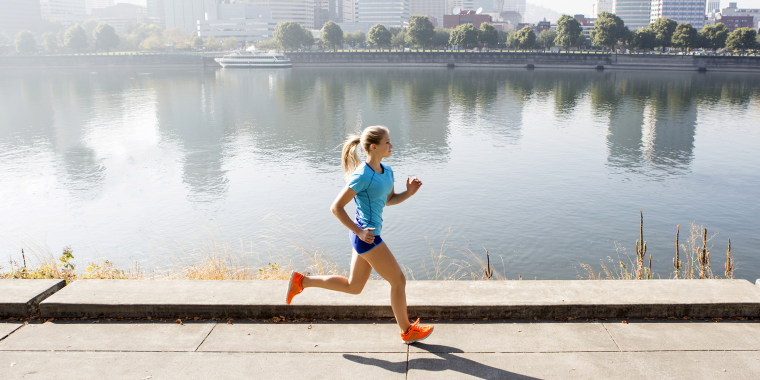With gyms closed during the coronavirus pandemic, many Americans are getting their exercise outdoors. Now there’s both good and bad news about the amount of unhealthy air they may be breathing in.
First, the concerning findings.
Almost half of the nation’s population is surrounded by polluted air, according to the American Lung Association’s 2020 State of the Air report, released on Tuesday. That amounts to 150 million people, or almost 9 million more compared to last year’s report.
The analysis comes on the heels of a Harvard University study that found COVID-19 patients who live in places with high levels of air pollution are more likely to die from the disease than people who reside in areas with cleaner air.
A small increase in long-term exposure to fine particulate matter — pollution that makes the air hazy, including particles that come from vehicle exhausts, wildfires and coal-fired power plants — lead to a large increase in the COVID-19 death rate, researchers found.
“That is a very troubling finding because in our report we show that millions and millions of people live in areas with unhealthy levels of particle pollution,” Paul Billings, national senior vice president of public policy at the American Lung Association, told TODAY.
“So if air pollution makes one more susceptible to poor health outcomes associated with COVID-19, that’s reason to be very concerned.”
Top 10 U.S. cities most polluted by year-round particle pollution are:
- Bakersfield, California
- Fresno-Madera-Hanford, California
- Visalia, California
- Los Angeles-Long Beach, California
- San Jose-San Francisco-Oakland, California
- Fairbanks, Alaska
- Phoenix-Mesa, Arizona
- (tie) El Centro, California
- (tie) Pittsburgh-New Castle-Weirton, Pennsylvania-Ohio-West Virginia
- Detroit-Warren-Ann Arbor, Michigan
The 21st annual State of the Air report analyzed data from 2016, 2017 and 2018 — three of the five hottest years recorded in global history, the American Lung Association noted.
Climate change continued to make air pollution worse, creating conditions for the formation of ozone, or smog, and creating dry conditions that drove wildfires, Billings said, calling the trend “disturbing.”
The top 10 most ozone-polluted U.S. cities are:
- Los Angeles-Long Beach, California
- Visalia, California
- Bakersfield, California
- Fresno-Madera-Hanford, California
- Sacramento-Roseville, California
- San Diego-Chula Vista-Carlsbad, California
- Phoenix-Mesa, Arizona
- San Jose-San Francisco-Oakland, California
- Las Vegas-Henderson, Nevada
- Denver-Aurora, Colorado
Pollution drops during coronavirus crisis
Still, this spring's lockdowns have dramatically improved air quality in parts of the country in recent weeks as people drive and fly less.
Satellite data showed a 30% drop in air pollution in March over the Northeast U.S. compared to the same time period in previous years, NASA reported this month. The agency noted the changes “have come at a high cost” as communities grapple with shelter-in-place orders.
Early spring is often a time for cleaner air anyway, but the crisis is creating a kind of “national experiment” that shows how reduced traffic impacts air quality and ultimately people’s health, Billings said.
“We do know that elevated levels of pollution are linked to a wide range of adverse health impacts — coughing, wheezing, shortness of breath,” he noted.
“It can trigger asthma attacks, COPD exacerbation, heart attacks, strokes and premature death. So if we’re seeing less air pollution, we’re undoubtedly seeing less adverse health consequences associated with pollution.”
But the changes could easily be wiped out by efforts to quickly ramp up economies: The Environmental Protection Agency confirmed the White House has relaxed enforcement of regulations to help polluting industries deal with the pandemic, NBC News reported this month.
The 2020 State of the Air report comes as the nation marks the 50th anniversary of the Clean Air Act and Earth Day.
“We still are seeing overall positive trends from when we first started doing the report 21 years ago,” Billings said. “Most people are breathing in dirty air less often than they did two decades ago.”
Some areas stand out in particular.
The cleanest U.S. cities, listed in alphabetical order, are:
- Bangor, Maine
- Burlington-South Burlington-Barre, Vermont
- Honolulu, Hawaii
- Wilmington, North Carolina
How to avoid dirty air while exercising outdoors:
The American Lung Association offered these tips:
- Don't exercise or run near busy intersections. Even though there may be less traffic during the coronavirus lockdowns, it’s still best to avoid pollution from cars.
- Get your exercise early in the morning before traffic and pollution levels rise.
- Monitor the air quality in your community by checking AirNow.gov before heading outside to exercise.
- A face mask won’t be of much help to filter out air pollution because the very small particles — which are the most lethal ones — will get through a cotton mask, Billings said. An N95 mask can help reduce exposure to the fine particles, but those masks are in short supply and needed by health care workers. Plus, they're tight-fitting and would be hard to exercise in.

